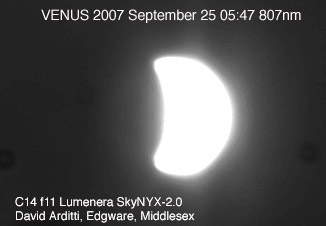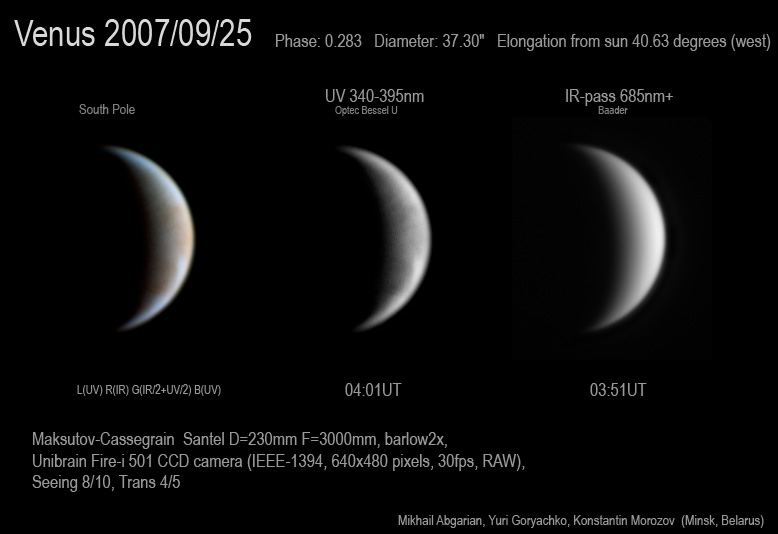金星 ALPO-Japan Latest

Venus Image 2007/09/25(UT)
David Arditti,Sean Walker,Yuri Goryachko
D.Arditti,Walker,Y.Goryachko
Following Richard McKim's "Ashen Light" alert I did observe Venus visually on
the morning of the 25th very carefully,with a C-14 at a wide variety of
magnifications,in a still-dark sky. I could not see any Ashen Light,and have
never been able to see it,in 30 years of looking. I would go so far as to say I
am certain there was no luminosity of the dark portion of the planet on this
occasion.
I then did another of my experiments in severely over-exposing the planet in the
IR. I have tried this at 807nm before,and got negative results on the night
side,but this is the first time I have used so large an aperture as the C-14. I
imaged at f11. Subjecting this image,below,to a substantial and careful levels
stretch in Photoshop,it seems to me that the night side glow may just about
be detected. This has been demonstrated before with 1000nm and 990nm filters,
where the effect seems to be much more visible. It may be faintly present at
807nm as well,but it is not clear. The camera stream rate was 30 fps,the
exposure was 33.3ms,gain was 14.5,and 50% of 1775 frames were stacked. No
sharpening was used.
I doubt the connection between the visual Ashen Light reports and the IR images
of the night side. These images require extreme processing to produce,and the
gap between the wavelength region they use,800-1000nm,and the visible,is very
large. All attempts to image the night side at wavelengths closer to the visual
have failed,and,the thermal glow effect,if it exists at all,is seen to be
excessively weak even at 807nm,which is still well beyond the visible. I
therefore don't think the Ashen Light can be related to the IR thermal glow of
the dark side. If the Ashen light exists,it is something else - occasional high
levels of Venusian lightening have been suggested,see Russell and Phillips:
 [David Arditti: Edgware Middlesex HA8 5LW: United Kingdom]
[David Arditti: Edgware Middlesex HA8 5LW: United Kingdom]
|
Sean Walker(313mm Newtonian) |
No sign of any IR emissions; I suspect Christophe was right- shoot in a black sky with Venus as a very thin crescent. The phaser is too large to reveal anything now.
Here is a UV image and RGB; IR was completely featurless.
 [ Sean Walker,Massachusetts,U.S.A]
[ Sean Walker,Massachusetts,U.S.A]
|
Yuri Goryachko & Konstantin Morozov(230mm Maksutov-Cassegrain) |
 [ゴルヤチコ:ミンスク- ベラルーシ]
[Yuri Goryachko & Konstantin Morozov: Minsk - Belarus]
[ゴルヤチコ:ミンスク- ベラルーシ]
[Yuri Goryachko & Konstantin Morozov: Minsk - Belarus]


[David Arditti: Edgware Middlesex HA8 5LW: United Kingdom]
[ Sean Walker,Massachusetts,U.S.A]
[ゴルヤチコ:ミンスク- ベラルーシ] [Yuri Goryachko & Konstantin Morozov: Minsk - Belarus]
 ALPO-Japan Latest
ALPO-Japan Latest

 Venus Section
Venus Section